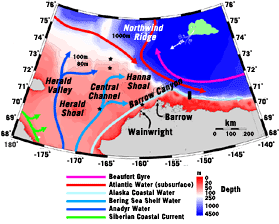|
|
 |
 |
 |
|
A schematic of the circulation over the
Chukchi Sea and Beaufort/Chukchi slope is presented above, showing the
three branches of the inflowing Pacific water. These branches are
color-coded with navy blue being the most nutrient-rich waters and
light blue being the least nutrient-rich. The Siberian Coastal Current
(green) is present in summer and fall, but absent or weak in winter
and spring. On the continental slope, the Pacific-origin water
encounters Atlantic-origin Water (red) which is flowing
counter-clockwise around the Arctic basin. Offshore of the slope, in
the interior of the Canada Basin, is the clockwise wind-driven flow of
the Beaufort Gyre (purple). |
|
Click to enlarge |
The Expedition - Objectives
Overview | Objectives | Science Crew | The Ship
Our multi-year project, which represents the physical oceanographic
component of SBI Phase 2, focuses on
understanding the flow of waters from the Bering Sea onto the Chukchi
and Beaufort shelves, and the subsequent transferral of these waters
into the deep Arctic basin.
Towards this end, two mooring arrays will be deployed: (1) A
widely-spaced array on the Chukchi shelf to measure the three branches
of inflowing Pacific-origin water from Bering Strait (indicated by the
black stars on the figure), and (2) A high-resolution array on the
Beaufort slope to measure exchange processes that transfer the
Pacific-origin water to the deep basin (indicated by the black line in
the figure). The Chukchi array is a joint University of Washington /
University of Alaska (UW/UAF) project, and the Beaufort array is being
deployed by the Woods Hole Oceanographic Institution (WHOI).
The purpose of our cruise on the USCGC Polar Star
is to deploy these arrays, and collect
additional hydrographic measurements along several key transects. The
moorings will sample over a period of 14 months. Next fall (2003) the
team will return to retrieve the data and put the moorings back into
the water for another year. In fall of 2004, the team will
recover the moorings in a final cruise.
UW/UAF project -
“The fate of a large and strongly
forced Arctic shelf outflow: Physical and biochemical process
studies”.
Objectives:
- To quantify the characteristics of the shelf flow in the Chukchi
Sea (e.g. transport, temperature, salinity), and to determine which
upstream processes are principally responsible for the variability
of these characteristics.
- To quantify the variability of the system on seasonal and
interannual timescales, and to assess what might be the connections
with a changing climate.
- To provide the temporal context of the Chukchi shelf water
properties and flows that will be essential for other SBI
investigators who are addressing the regional biochemical and
physical processes.
WHOI project -
“Dynamics of exchange in the Beaufort
Sea boundary current system: Implications for interior ventilation”.
Objectives:
- To quantify the mean and seasonally varying transport, structure,
and water mass content of the boundary current system downstream of
the Chukchi Sea outflow points.
- To determine the nature and cause of the mesoscale variability of
the boundary current, and assess the impact of the variability on the
cross-stream exchange of mass and properties.
- To identify the dynamics of the secondary circulation.
- To elucidate the source of the eddies in the interior western
Arctic by comparing the seasonally changing boundary current water to
the observed characteristics of the mid-basin eddy field.
These two projects together will improve our understanding of the fate
of Pacific-origin water in the western Arctic, and its impact on the
ventilation of the interior basin. The physical data will also
provide an important
context for the biochemical measurements being carried out as part of
SBI.
|
|




